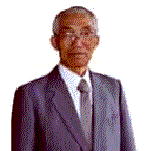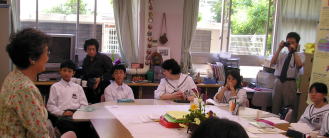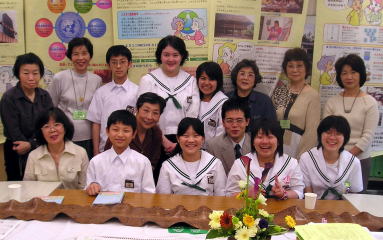No.208-R
Dr. Shigeo TAJIMA receives eDistinguished Leadership Award for Internationalsf. Congratulations!
 Dr. Shigeo TAJIMA, an adviser to the Meguro UNESCO
Association, was awarded a testimonial as a distinguished leader from his alma
mater, the University of Minnesota. He earned an M.S. in agricultural education
there in 1955. Later, he returned to Japan to gain his Ph.D. in agriculture
from Hokkaido University, and then assumed the professorship at Obihiro
University of Agriculture and Veterinary Medicine. He became director of the
Division of Agricultural Education and Science at the UNESCO headquarters in
Paris in 1968. He also contributed himself to the UNESCO activities in many
ways in Japan, including being a member of the Japanese National Commission for
UNESCO, a member of the board of governors of the National Federation of UNESCO
Associations in Japan, and vice president of the Meguro UNESCO Association.
Dr. Shigeo TAJIMA, an adviser to the Meguro UNESCO
Association, was awarded a testimonial as a distinguished leader from his alma
mater, the University of Minnesota. He earned an M.S. in agricultural education
there in 1955. Later, he returned to Japan to gain his Ph.D. in agriculture
from Hokkaido University, and then assumed the professorship at Obihiro
University of Agriculture and Veterinary Medicine. He became director of the
Division of Agricultural Education and Science at the UNESCO headquarters in
Paris in 1968. He also contributed himself to the UNESCO activities in many
ways in Japan, including being a member of the Japanese National Commission for
UNESCO, a member of the board of governors of the National Federation of UNESCO
Associations in Japan, and vice president of the Meguro UNESCO Association.
The award was given for his long-term
contributions as an educator and his excellent leadership roles both nationally
and internationally. He has worked for the Ministry of Education, Culture,
Sports, Science and Technology in Japan and the Ministry of Agriculture,
Forestry and Fisheries, in Japan. He has also worked for UNESCO, OECD and APO.
He is eighty-two years old this year, and is still working hard as the
professor emeritus of Obihiro University of Agriculture and Veterinary
Medicine, a member of the board of governors and councils at two agricultural
colleges, and the honorary president of the Asia Pacific Association of
Educators in Agriculture and Environment.
The detailed information of the award is
on the website of the Minnesota University. The picture above is from the page:http://www.international.umn.edu/awards/leader/2004/tajima.html
The University of Minnesota has a very
useful article entitled eHuman Rights Documents and Materialsf
(including a Japanese language version)
on its website. Visiting the page is highly recommended:http://www1.umn.edu/humanrts/index.html
Shirakawa Junior High
School Students Visit Our Secretariat
 On 26th May, a hot day,
seven students of Shirakawa Junior High School (founded by Shirakawa village,
Gifu prefecture) with their teacher, Mr. Junya Ogawa, visited the secretariat
of Meguro UNESCO Association. This visit was a part of their school trip
program. Their hometown is a very quiet place surrounded by mountains of about
2000 meters high, so they seemed to be surprised at the crowdedness and hot
weather in Tokyo.
On 26th May, a hot day,
seven students of Shirakawa Junior High School (founded by Shirakawa village,
Gifu prefecture) with their teacher, Mr. Junya Ogawa, visited the secretariat
of Meguro UNESCO Association. This visit was a part of their school trip
program. Their hometown is a very quiet place surrounded by mountains of about
2000 meters high, so they seemed to be surprised at the crowdedness and hot
weather in Tokyo.
Shirakawa village is famous for its
style of housing with thatched rafter roofs, and is one of the UNESCO World
Heritage Sites. So our conversation started about the process of designating
UNESCO World Heritage Sites, the current situation of these sites and some
problems concerning them. We talked about sites designated as World Cultural
Heritage, World Natural Heritage, World Cultural And Natural Heritage, and
World Heritage In Danger. We shared the view that we should maintain respect
for a variety of heritage sites and the culture contained in these sites.
A student raised a good
question to the staff of the secretariat: eMany say that Japanese children are
in happy environments, but we hardly realize it. Please tell us the situations
faced by children of other countriesf. So the staff explained the World Terakoya Movement run by UNESCO. Mrs.
Hashimoto, vice president of Meguro UNESCO Association, talked about a Terakoya
project she visited in Vietnam last year. She mentioned that there were many
races isolated from one
another by steep mountains and that each race had its
own language. She continued that people there need to learn a common language
to deepen mutual understanding between races but this raises the fear that they
might lose their individual culture. We shared our views well on this topic.
Shirakawa
Junior High School is a small school of only 50 pupils. Second-year students
have a school study tour in Australia. This tour is very beneficial for the
students to put the knowledge obtained through their experiences abroad to the
activities in their own community. For example, the
list of activities for the 2003 school year shows
that the students took part in some community-based activities, including roof
thatching and whole-village beautification. They enjoyed involving themselves
in these activities as community members. This reminds us of the words eTHINK
GLOBALLY AND ACT LOCALLYf. They told us that their dialect eHansukutaif means
eirairasuru=irritatingf. We were very impressed
by their attitude, learning English while valuing the dialect of their
hometown. We would like to have days without saying eHansukutaif. We appreciate
the fruitful time we share with these students. - Fumiko Miyazaki, Youth Activity Committee
next page
 Dr. Shigeo TAJIMA, an adviser to the Meguro UNESCO
Association, was awarded a testimonial as a distinguished leader from his alma
mater, the University of Minnesota. He earned an M.S. in agricultural education
there in 1955. Later, he returned to Japan to gain his Ph.D. in agriculture
from Hokkaido University, and then assumed the professorship at Obihiro
University of Agriculture and Veterinary Medicine. He became director of the
Division of Agricultural Education and Science at the UNESCO headquarters in
Paris in 1968. He also contributed himself to the UNESCO activities in many
ways in Japan, including being a member of the Japanese National Commission for
UNESCO, a member of the board of governors of the National Federation of UNESCO
Associations in Japan, and vice president of the Meguro UNESCO Association.
Dr. Shigeo TAJIMA, an adviser to the Meguro UNESCO
Association, was awarded a testimonial as a distinguished leader from his alma
mater, the University of Minnesota. He earned an M.S. in agricultural education
there in 1955. Later, he returned to Japan to gain his Ph.D. in agriculture
from Hokkaido University, and then assumed the professorship at Obihiro
University of Agriculture and Veterinary Medicine. He became director of the
Division of Agricultural Education and Science at the UNESCO headquarters in
Paris in 1968. He also contributed himself to the UNESCO activities in many
ways in Japan, including being a member of the Japanese National Commission for
UNESCO, a member of the board of governors of the National Federation of UNESCO
Associations in Japan, and vice president of the Meguro UNESCO Association.
